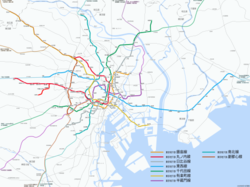
Back Tokio metrosu Azerbaijani توکیو متروسو AZB Токийско метро Bulgarian টোকিও মেট্রো Bengali/Bangla Tokyo Metro Danish Tōkyō Metro German Tokyo Metro Esperanto Tōkyō metroo Estonian شرکت متروی توکیو Persian Tōkyō metro Finnish
This article needs additional citations for verification. (May 2014) |
| Tokyo Metro | |||
|---|---|---|---|
 | |||
| Overview | |||
| Native name | 東京メトロ Tōkyō Metoro | ||
| Owner | Tokyo Metro Co., Ltd. (public kabushiki gaisha controlled by the Government of Japan (26.71%) and the Tokyo Metropolitan Government (23.29%); traded as TYO: 9023) | ||
| Locale | Greater Tokyo Area, Japan | ||
| Transit type | Rapid transit | ||
| Number of lines | 9[1] | ||
| Number of stations | 180[1] | ||
| Daily ridership | 6.52 million (FY2023)[2] | ||
| Website | Tokyo Metro | ||
| Operation | |||
| Began operation | 30 December 1927 as Tokyo Underground Railway (1941 as Teito Rapid Transit Authority; 2004 under current name) | ||
| Operator(s) | Tokyo Metro Co., Ltd. | ||
| Number of vehicles | 2,773 cars (2012)[1] | ||
| Technical | |||
| System length | 195.1 km (121.2 mi)[1] | ||
| Track gauge | 1,067 mm (3 ft 6 in) 1,435 mm (4 ft 8+1⁄2 in) standard gauge (Ginza & Marunouchi lines) | ||
| Electrification | 1,500 V DC overhead catenary 600 V DC third rail (Ginza & Marunouchi lines) | ||
| Top speed | 80 km/h (50 mph) 100 km/h (62 mph) (Tōzai Line) 65 km/h (40 mph) (Ginza Line) 75 km/h (47 mph) (Marunouchi Line) | ||
| |||
The Tokyo Metro (Japanese: 東京メトロ, Tōkyō Metoro) is a major rapid transit system in Tokyo, Japan, operated by the Tokyo Metro Co. With an average daily ridership of 6.52 million passengers (as of 2023), the Tokyo Metro is the larger of the two subway operators in the city; the other being the Toei Subway, with 2.85 million average daily rides.[2][3]
- ^ a b c d Cite error: The named reference
lineswas invoked but never defined (see the help page). - ^ a b 営業状況 [Business Conditions] (in Japanese). 東京地下鉄株式会社 [Tokyo Metro Co., Ltd.] Retrieved 2024-08-18.
- ^ 東京都交通局ホーム - 経営情報 - 交通局の概要 - 都営地下鉄 [Tokyo Metropolitan Bureau of Transportation Home - Management Information - Overview of the Department of Transportation - Toei Subway] (in Japanese). 東京都交通局 [Tokyo Metropolitan Bureau of Transportation]. Retrieved 2015-11-24.
